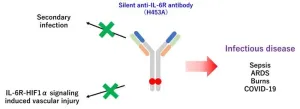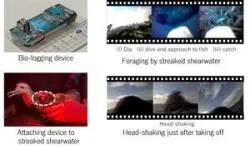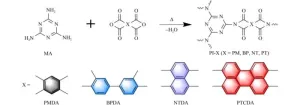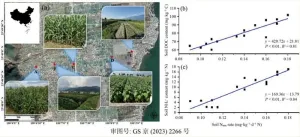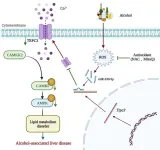(Press-News.org) Osaka, Japan – Cytokines are chemical messengers that help the body get rid of invading bacteria and viruses, and control inflammation. The body carefully balances cytokines because they help keep the immune system healthy. However, this balance is upset if the immune system overreacts. A serious infection or a severe burn can unleash a cytokine storm in the body. During the storm—also called cytokine release syndrome (CRS)—the body produces too many cytokines, leading to life-threatening inflammation.
Interleukin-6 (IL-6) is a key cytokine in the storm because it helps to drive the inflammation that damages the body. IL-6 delivers its message by fastening to IL-6 receptors within cells, which tells the cells to spread inflammation. Because IL-6 is important in CRS, treatments that block the IL-6 signal can relieve inflammation. However, this blocking tends to be long-lasting, which leads to side effects.
In a study published this month in the Proceedings of the National Academy of Sciences (PNAS), researchers from Osaka University have discovered a way to block IL-6 signals while minimizing treatment side effects. The group interrupted the inflammatory signal using an antibody that blocks the IL-6 receptor for only a short time. The brief interruption was long enough to protect the tissues against injury from cytokine storms caused by sepsis or severe burns.
“Our results suggest that CRS can be treated with an IL-6 receptor antibody that has a short half-life,” says the study's lead author Sujin Kang. “This can prevent vascular damage and at the same time reduce the side effects associated with blocking IL-6.”
Vascular damage happens when an infection or burn causes the cells that line the inner surface of blood vessels to become leaky. The leaking fluid triggers a cytokine storm and can cause a secondary infection. The group also reported a potential mechanism for this damage to cells. When IL-6 binds to its receptor it activates a protein called hypoxia-inducible factor-1α (HIF1α), which amplifies inflammation.
“We found that blocking the IL-6R–HIF1α signal strengthened vascular endothelial cells and improved vessel integrity. This helped to prevent leakage from the vessels and relieved the inflammation caused by CRS,” explains senior author Tadamitsu Kishimoto. “We hope this will help patients suffering from CRS and other inflammatory diseases in the future.”
Other diseases that can cause CRS include sepsis and acute respiratory distress syndrome, COVID-19 infection, and ischemia. People with traumatic injuries and those taking some cancer immunotherapies can also experience a cytokine storm. The findings of this study can hopefully provide an alternative therapeutic approach to patients with these conditions.
###
The article, “Gp130–HIF1α axis–induced vascular damage is prevented by the short-term inhibition of IL-6 receptor signaling,” was published in the Proceedings of the National Academy of Sciences (PNAS) at DOI: https://doi.org/10.1073/pnas.2315898120
About Osaka University
Osaka University was founded in 1931 as one of the seven imperial universities of Japan and is now one of Japan's leading comprehensive universities with a broad disciplinary spectrum. This strength is coupled with a singular drive for innovation that extends throughout the scientific process, from fundamental research to the creation of applied technology with positive economic impacts. Its commitment to innovation has been recognized in Japan and around the world, being named Japan's most innovative university in 2015 (Reuters 2015 Top 100) and one of the most innovative institutions in the world in 2017 (Innovative Universities and the Nature Index Innovation 2017). Now, Osaka University is leveraging its role as a Designated National University Corporation selected by the Ministry of Education, Culture, Sports, Science and Technology to contribute to innovation for human welfare, sustainable development of society, and social transformation.
Website: https://resou.osaka-u.ac.jp/en
About Immunology Frontier Research Center (IFReC), Osaka University
IFReC was established by the support of the World Premier International Research Center Initiative (WPI) in 2007. IFReC aims to overcome immune-related diseases by clarifying the whole picture of the immune system, and has promoted globally competitive fundamental research with excellent researchers from overseas.
Website: https://www.ifrec.osaka-u.ac.jp/en/
END
A new targeted treatment calms the cytokine storm
Researchers from Osaka University discover a novel treatment strategy for cytokine storm, a serious inflammatory syndrome triggered by an infection or severe burn
2024-01-17
ELSE PRESS RELEASES FROM THIS DATE:
Tiny AI-based bio-loggers revealing the interesting bits of a bird’s day
2024-01-17
Osaka, Japan – Have you ever wondered what wildlife animals do all day? Documentaries offer a glimpse into their lives, but animals under the watchful eye do not do anything interesting. The true essence of their behaviors remains elusive. Now, researchers from Japan have developed a camera that allows us to capture these behaviors.
In a study recently published in PNAS Nexus, researchers from Osaka University have created a small sensor-based data logger (called a bio-logger) that automatically detects and records video of infrequent behaviors in wild seabirds without supervision by researchers.
Infrequent behaviors, such as diving into the water for food, can ...
SDG-washing found among Canada's top companies
2024-01-17
Canada's biggest companies often speak of their plans to be more sustainable, but a new study found corporations aren't fully backing up those commitments.
A team of University of Waterloo researchers concluded that corporate investing in communities fell despite an increase in companies committing to the United Nation's Sustainable Development Goals (SDGs) over the last decade.
Researchers investigated the community investment of Canada's 58 leading private-sector companies as a percentage of their net profit after tax to determine whether introducing SDGs created ...
Enhanced photoelectrochemical water splitting with a donor-acceptor polyimide
2024-01-17
Polyimide (PI) has emerged as a promising organic photocatalyst owing to its distinct advantages of high visible-light response, facile synthesis, molecularly tunable donor-acceptor structure, and excellent physicochemical stability. However, the synthesis of high-quality PI photoelectrode remains a challenge, and photoelectrochemical (PEC) water splitting for PI has been less studied.
A research group of Huiyan Zhang and Sheng Chu from Southeast University prepared PI films by a ...
Spider venom heart drug a step closer
2024-01-17
A spider venom molecule being investigated by a University of Queensland team has met critical benchmarks towards becoming a treatment for heart attack and stroke.
Associate Professor Nathan Palpant and Professor Glenn King from UQ’s Institute for Molecular Bioscience have previously shown that the drug candidate Hi1a protects cells from the damage caused by heart attack and stroke.
Dr Palpant said a subsequent study has put the drug through a series of preclinical tests designed to mimic real-life treatment scenarios.
“These tests are a major step towards helping us understand how Hi1a would work ...
Is soil nitrogen mineralization important in agricultural intensive areas?
2024-01-17
Soil nitrogen mineralization (Nmin) is a key process that converts organic N into mineral N that controls soil N availability to plants. However, regional assessments of soil Nmin in cropland and its affecting factors are lacking, especially in relation to variation in elevation. Nitrogen is an essential nutrient for crops but mineral N in soil, the only form that can be absorbed and used by crops, represents only about 1% of total soil N. Although N fertilization is commonly a necessary method for supplying N to crops, N release due to excess N fertilizer in the environment ...
Hepatic TRPC3: an emerging regulator of alcohol-associated liver disease
2024-01-17
Excessive alcohol intake is strongly associated with alcohol-associated liver disease (ALD) which accounts for 25% and 30% of deaths from cirrhosis and hepatocellular carcinoma. Impairment of Ca2+ influx and Ca2+-mediated signaling in ALD suggests that Ca2+ channels are important in ALD pathological progression.
TRPC (transient receptor potential cation channel protein C) is an evolutionarily conserved non-selective cation channel protein primarily located in the cell membrane with six transmembrane segments. So far four TRPC subfamilies have been identified, categorized into TRPC1, TRPC2, TRPC4/5, and TRPC3/6/7. Among them, TRPC3 is the most well-studied ...
USC Stem Cell study throws our understanding of gene regulation for a loop
2024-01-17
The blueprint for human life lies within the DNA in the nucleus of each of our cells. In human cells, around six and a half feet of this genetic material must be condensed to fit inside the nucleus. DNA condensation is not random. To function properly, the genetic material is highly organized into loop structures that often bring together widely separated sections of the genome critical to the regulation of gene activity. In a new paper published in Nature Communications, USC Stem Cell scientists from the laboratory ...
A manned submersible found a fault scarp of the 2011 Tohoku-oki megaquake in the Japan Trench
2024-01-17
Niigata, Japan – On September 4, 2022, a geologist Hayato Ueda in Niigata University boarded a submarine vehicle with a pilot Chris May and had a dive into the Japan Trench within the epicenter area of the 2011 Tohoku-oki megaquake, which caused the devastating tsunami disaster. On the 7,500 m deep trench bottom, they found a 26 m high nearly vertical cliff on the eastern slope of a 60 m high ridge. Previous bathymetric surveys from the sea surface have revealed that the ridge did not exist before, and appeared just after the megaquake ...
Video gamers worldwide may be risking irreversible hearing loss and/or tinnitus
2024-01-17
Video gamers worldwide may be risking irreversible hearing loss and/or tinnitus—persistent ringing/buzzing in the ears—finds a systematic review of the available evidence, published in the open access journal BMJ Public Health.
What evidence there is suggests that the sound levels reported in studies of more than 50,000 people often near, or exceed, permissible safe limits, conclude the researchers.
And given the popularity of these games, greater public health efforts are needed to raise awareness of the potential ...
Enlarged breast tissue in men (gynaecomastia) linked to heightened risk of death
2024-01-17
Men with enlarged breast tissue, not caused by excess weight—a condition formally known as gynaecomastia—may be at heightened risk of an early death before the age of 75, suggests the first study of its kind, published online in the open access journal BMJ Open.
Those with a pre-existing risk factor, such as cancer or circulatory, lung, and gut diseases before diagnosis seem to be most vulnerable, the findings indicate.
Enlarged breast tissue in men is usually caused by a hormone imbalance and affects around a third to around two thirds of men, depending on age. It is distinct from what is often dubbed ...
LAST 30 PRESS RELEASES:
New expert guidance urges caution before surgery for patients with treatment-resistant constipation
Solar hydrogen can now be produced efficiently without the scarce metal platinum
Sleeping in on weekends may help boost teens’ mental health
Study: Teens use cellphones for an hour a day at school
After more than two years of war, Palestinian children are hungry, denied education and “like the living dead”
The untold story of life with Prader-Willi syndrome - according to the siblings who live it
How the parasite that ‘gave up sex’ found more hosts – and why its victory won’t last
When is it time to jump? The boiling frog problem of AI use in physics education
Twitter data reveals partisan divide in understanding why pollen season's getting worse
AI is quick but risky for updating old software
Revolutionizing biosecurity: new multi-omics framework to transform invasive species management
From ancient herb to modern medicine: new review unveils the multi-targeted healing potential of Borago officinalis
Building a global scientific community: Biological Diversity Journal announces dual recruitment of Editorial Board and Youth Editorial Board members
Microbes that break down antibiotics help protect ecosystems under drug pollution
Smart biochar that remembers pollutants offers a new way to clean water and recycle biomass
Rice genes matter more than domestication in shaping plant microbiomes
Ticking time bomb: Some farmers report as many as 70 tick encounters over a 6-month period
Turning garden and crop waste into plastics
Scientists discover ‘platypus galaxies’ in the early universe
Seeing thyroid cancer in a new light: when AI meets label-free imaging in the operating room
Neutrophil-to-lymphocyte ratio may aid risk stratification in depressive disorder
2026 Seismological Society of America Annual Meeting
AI-powered ECG analysis offers promising path for early detection of chronic obstructive pulmonary disease, says Mount Sinai researchers
GIMM uncovers flaws in lab-grown heart cells and paves the way for improved treatments
Cracking the evolutionary code of sleep
Medications could help the aging brain cope with surgery, memory impairment
Back pain linked to worse sleep years later in men over 65, according to study
CDC urges ‘shared decision-making’ on some childhood vaccines; many unclear about what that means
New research finds that an ‘equal treatment’ approach to economic opportunity advertising can backfire
Researchers create shape-shifting, self-navigating microparticles
[Press-News.org] A new targeted treatment calms the cytokine stormResearchers from Osaka University discover a novel treatment strategy for cytokine storm, a serious inflammatory syndrome triggered by an infection or severe burn
